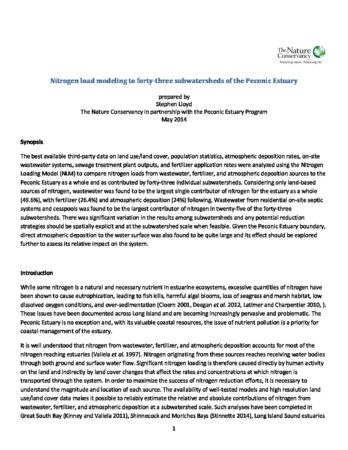The Nature Conservancy produced this report detailing the results of a Nitrogen Load Model (NLM) applied for forty-three subwatersheds in the Peconic Estuary Watershed. The best available third-party data on land use/land cover, population statistics, atmospheric deposition rates, on-site wastewater systems, sewage treatment plant outputs, and fertilizer application rates were analyzed using the NLM to compare nitrogen loads from wastewater, fertilizer, and atmospheric deposition sources to the Peconic Estuary as a whole and as contributed by forty-three individual subwatersheds. Considering only land-based sources of nitrogen, wastewater was found to be the largest single contributor of nitrogen for the estuary as a whole (49.6%), with fertilizer (26.4%) and atmospheric deposition (24%) following. Wastewater from residential on-site septic systems and cesspools was found to be the largest contributor of nitrogen in twenty-five of the forty-three subwatersheds. There was significant variation in the results among subwatersheds and any potential reduction strategies should be spatially explicit and at the subwatershed scale when feasible. Given the Peconic Estuary boundary, direct atmospheric deposition to the water surface was also found to be quite large and its effect should be explored further to assess its relative impact on the system.

